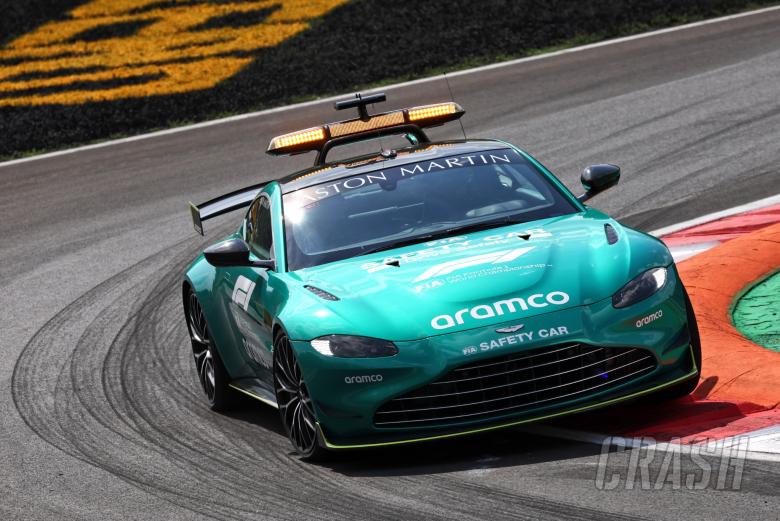Safety Car F1 rules 2023 explained: What happened in Abu Dhabi and Monza?


The FIA Safety Car plays an important role during an F1 grand prix when required. But what are the rules surrounding how the Safety Car should operate?
Since 2021 F1 has had two official Safety Cars, one supplied by Mercedes, and one supplied by Aston Martin. The Safety Cars alternate throughout the season and are driven by Bernd Maylander, who has been driving the Safety Car in F1 since 2000.
F1’s sporting regulations stipulate that the Safety Car “may be brought into operation to neutralise a race upon the order of the clerk of the course” and will be used “only if competitors or officials are in immediate physical danger on or near the track but the circumstances are not as such as to necessitate suspending the race.”
Before the race can be resumed, three things must happen.
The cars between the Safety Car and the leader firstly need to be let through.
Lapped cars need to be allowed to overtake the Safety Car.
The Safety Car returns to the pits at the end of the following lap.
Each lap completed under the Safety Car is counted as a race lap.
The FIA can also call upon the Virtual Safety Car to neutralise a practice session or a race.
This is normally used “when double waved yellow flags are needed on any section of track and competitors or officials may be in danger, but the circumstances are not such as to warrant use of the Safety Car itself.”
The Virtual Safety Car - or VSC - was first introduced for the 2015 season after being developed in response to Jules Bianchi’s tragic accident at the 2014 Japanese Grand Prix. Bianchi died nine months after suffering severe head injuries when he crashed into a recovery vehicle in heavy rain.
The use of F1’s Safety Car has made the headlines as a subject of great debate and controversy, particularly regarding the handling of race-ending Safety Car periods during the 2021 Abu Dhabi Grand Prix and 2022 Italian Grand Prix.
The FIA published an updated version of the Sporting Regulations ahead of the 2022 F1 season that featured a revision to the Safety Car regulation regarding lapped cars.
Article 55.13 now reads: “If the clerk of the course considers it safe to do so, and the message 'LAPPED CARS MAY NOW OVERTAKE' has been sent to all Competitors using the official messaging system, all cars that have been lapped by the leader will be required to pass the cars on the lead lap and the Safety Car.”
The change replaced the phrasing which read “any” rather than “all” lapped cars are required to overtake and rejoin at the back of the field prior to the restart. The alteration was made to prevent a repeat of the controversial 2021 title decider in Abu Dhabi.
What happened in Abu Dhabi?
Michael Masi left his job as race director after failing to apply the rules correctly in two instances during a late Safety Car in the 2021 Abu Dhabi Grand Prix.
First, Masi allowed only the five drivers - Lando Norris, Fernando Alonso, Esteban Ocon, Charles Leclerc and Sebastian Vettel - sitting between title rivals Lewis Hamilton and Max Verstappen to unlap themselves.
However, the lapped cars of Daniel Ricciardo, Lance Stroll and Mick Schumacher sitting between Verstappen and Carlos Sainz were not allowed to unlap themselves.
Masi ended up forcing a restart on the final lap of the race, which in turn failed to follow the requirement that races must be restarted “at the end of the following lap” after the message has been relayed that lapped cars can overtake.
Masi’s handling of the restart directly altered the outcome of the world championship.
Hamilton had dominated the race and was on course to win a record-breaking eighth drivers’ crown, but the last-lap restart handed the advantage to Verstappen, who, on fresh soft tyres, overtook the Mercedes driver to clinch the world title.
What happened at Monza?
The 2022 Italian Grand Prix ended in anticlimactic fashion when it finished behind the Safety Car, with Verstappen denying Leclerc and Ferrari a home win in front of the Tifosi.
Unlike in Abu Dhabi, on this occasion the Safety Car procedure was followed to the letter of the rulebook.
Drivers and team principals were left frustrated at how long it took to clear the track and the rather clumsy nature in which the race ended.
The Safety Car was deployed on Lap 48, a lap after Daniel Ricciardo’s McLaren broke down.
The failed restart was complicated by Ricciardo’s car getting stuck in gear, which considerably slowed the recovery process, as well as the fact the Safety Car picked up third-place George Russell instead of race-leader Verstappen.
Verstappen winning under the Safety Car was met by boos and jeers from a partisan home crowd, who were hoping to see Leclerc get the chance to challenge for victory.
The end to the race at Monza subsequently sparked a debate over whether F1 needs to rethink its Safety Car rules.
Will Safety Car rules change?
The FIA met with F1 team principals in the wake of the 2022 Italian Grand Prix to discuss several topics, including the conclusion to the race at Monza.
Lewis Hamilton initially called for races to be extended, if they are set to conclude with a Safety Car on track.
Ferrari boss Mattia Binotto argued that the rule should not change - but the race directors' implementation of the current rule must be slicker.

